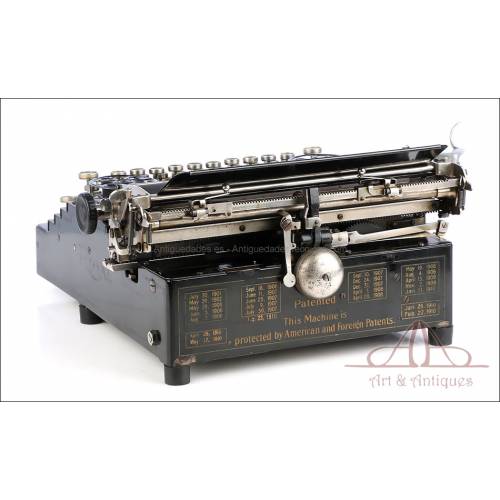Antique Typewriters
Typewriters, a long history of success
If the invention of writing marked the beginning of history itself, the appearance of the typewriter made it possible to refine this technique to unsuspected limits. The first great example came around 1865 under the signature of Rasmus Malling-Hansen. This prototype, named Malling-Hansen in honor of its in...
Typewriters, a long history of success
If the invention of writing marked the beginning of history itself, the appearance of the typewriter made it possible to refine this technique to unsuspected limits. The first great example came around 1865 under the signature of Rasmus Malling-Hansen. This prototype, named Malling-Hansen in honor of its inventor, was not exactly the first machine of its kind, but it was a pioneer in terms of its commercialization. The path continued in the following decades with the contributions of Remington or Hammond among others, which brought the machines to high levels of popularity. In the first decades of the 20th century, their use was already universal thanks to firms such as Smith Premier or Olivetti, with the arrival of the electric models developed by the International Business Machines Corporation. Today, such a fascinating world is the object of desire of collectors from all over the world.
The great names in antique typewriters
If the general history of typewriters is fascinating, knowing the who's who of the manufacturers who popularized them is a must for collectors.
- Remington: driven mainly by the American Christopher Latham Sholes, it was the first major manufacturer.
- Caligraph - American Writing Machine Company: perfected the manufacture of typewriters to compete head-to-head with Remington. It operated between 1880 and 1908.
- Hammond: founded by James Bartlett Hammond in 1880, his workshop produced the first polyglot machine and a new technical concept. It kept its original name until 1926.
- Yost: synonymous with sophistication, it was born in 1888 driven by George Yost, who had previously worked with Scholes and Caligraph. It remained on the market until 1908.
- Smith Premier: another representative of the early stages of the typewriter industry emerged in 1890 from a gun factory (L.C. Smith & Brothers) and was acquired by Remington in 1908.
- Olivetti: already in the 20th century, Camillo Olivetti was the driving force behind the first major European company (1908). Unlike its predecessors, it is still active today, although oriented towards electronics.
- Underwood: John Thomas Underwood founded it in 1895 and, despite starting behind its main rivals, managed to survive almost all of them and continues to manufacture (with a different orientation) today.
- Many more: Densmore or National Typewriter Company would be other notable examples among several dozens of them
Types of antique typewriters
The first major criterion for classifying these antiques is whether or not they have a keyboard. In the first case, those with an index stand out, which were in turn divided into those with a circular, quadrangular or linear format, being very rare examples and, therefore, coveted. Among those with a keyboard, the main classification criterion is the key stroke (lower, upper, front, rosette...). Finally, the keyboard layout is another important factor for placing machines in one category or another. In spite of the common characteristics, each historical model has some singularities that make it unique and valuable.
Antique Torpedo Typewriter Model 6. Germany, Circa 1925 Antique Torpedo Typewriter Model...
Imposing antique Torpedo 6 typewriter. With German keyboard and in good working order. Imposing antique Torpedo 6...
SoldAntique Continental Typewriter. Germany, Circa 1930 Antique Continental Typewriter....
Beautiful Continental typewriter with German keyboard and special keys. In very good condition and fine working order. Beautiful Continental typewriter with...
SoldAntique Mercedes Typewriter. Working. Germany, Circa 1930 Antique Mercedes Typewriter....
Beautiful Mercedes typewriter in excellent working order. German keyboard. Beautiful Mercedes typewriter in...
SoldAntique Hammond 12 Typewriter with Curved Keyboard. USA, 1905 Antique Hammond 12 Typewriter...
Rare and magnificent Hammond 12 typewriter. In excellent condition and working order. Rare and magnificent Hammond 12...
SoldAntique Continental Typewriter. Working. Germany, Circa 1930 Antique Continental Typewriter....
Astonishing German Continental typewriter in excellent condition. It works and types really fine. Astonishing German Continental...
SoldAntique Underwood 5 Typewriter. Spanish Keyboard. USA circa 1925 Antique Underwood 5 Typewriter....
Striking Underwood typewriter refinished in red. Collectors piece in perfect working order. Striking Underwood typewriter...
SoldAntique Royal Model 5 Typewriter. England, Circa 1910 Antique Royal Model 5...
Amazing Royal 5 typwewriter Flatbed in very good working order. Original design. Amazing Royal 5 typwewriter Flatbed...
SoldAntique Torpedo 6 Typewriter in Museum Condition. Germany, 1930s Antique Torpedo 6 Typewriter in...
Outstanding Torpedo 6 typewriter in exceptional condition. Almost like new. In perfect working order. Outstanding Torpedo 6 typewriter in...
Sold
New products
-

Antique ivory and silver plated stethoscope, late 19th century
Antique stethoscope from the late 19th century in silver-plated metal...
-

Vintage pendant with shell cameo of Jesús del Gran Poder, carved c. 1970
Vintage pendant with a shell-carved cameo of Jesus del Gran Poder, circa...
-

Antique Roman Style Gilded Silver Chalice with Paten. France, 1932
Antique Roman-style chalice in gilded silver with paten. France, 1932....
-

Beautiful Antique 18 K Gold Ring with 7 Natural Diamonds
Antique 18K gold ring with 7 natural diamonds. Delicate openwork design,...
-

Antique Silver Reliquary. José Vilaplana. Valencia, Spain. Circa 1920
Impressive repoussé silver reliquary by José Vilaplana, Valencia, c....
-

Vintage 18K Gold Ring with 7 Natural Diamonds
Vintage 18K gold ring with seven natural diamonds in floral setting....
-

Antique Silver Chalice. Enameled Crosses. Valencia, Spain, 1942
Spanish chalice from 1942 in solid silver, gifted by the Church of...
-

Antique Silver Chalice and Paten. Granada Spain, circa 1900
Spanish chalice in white silver with matching paten, handcrafted....
Specials
-

Antique Gilt Silver Chalice with Iconography of Saints and Paten, c. 1900
Spanish gilt silver chalice (900...

















